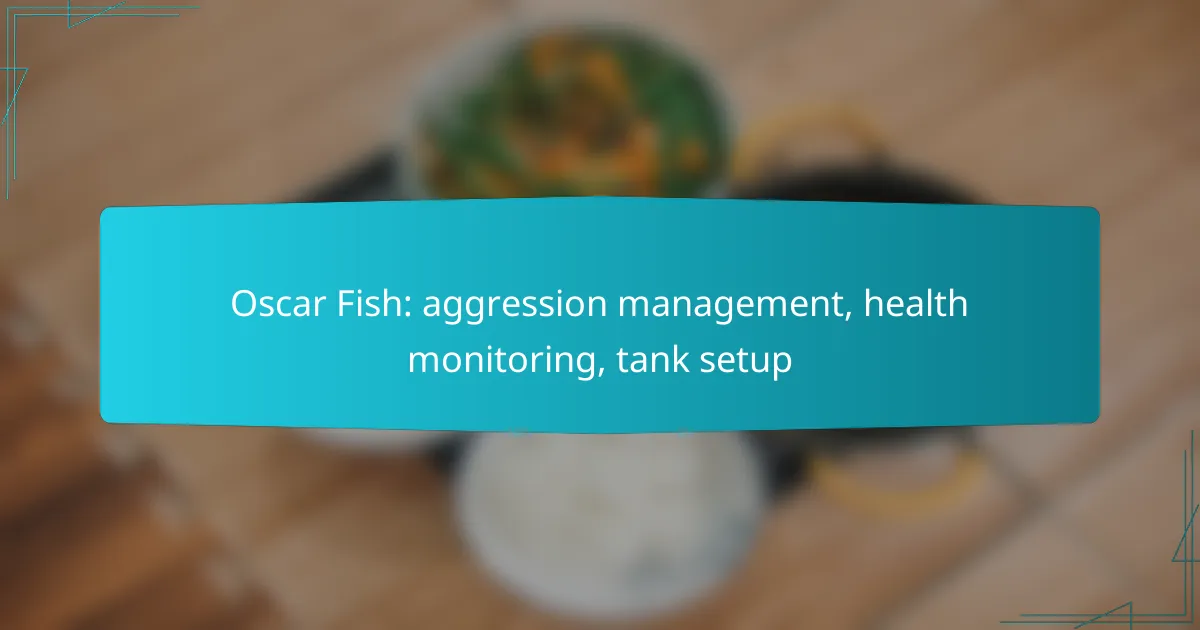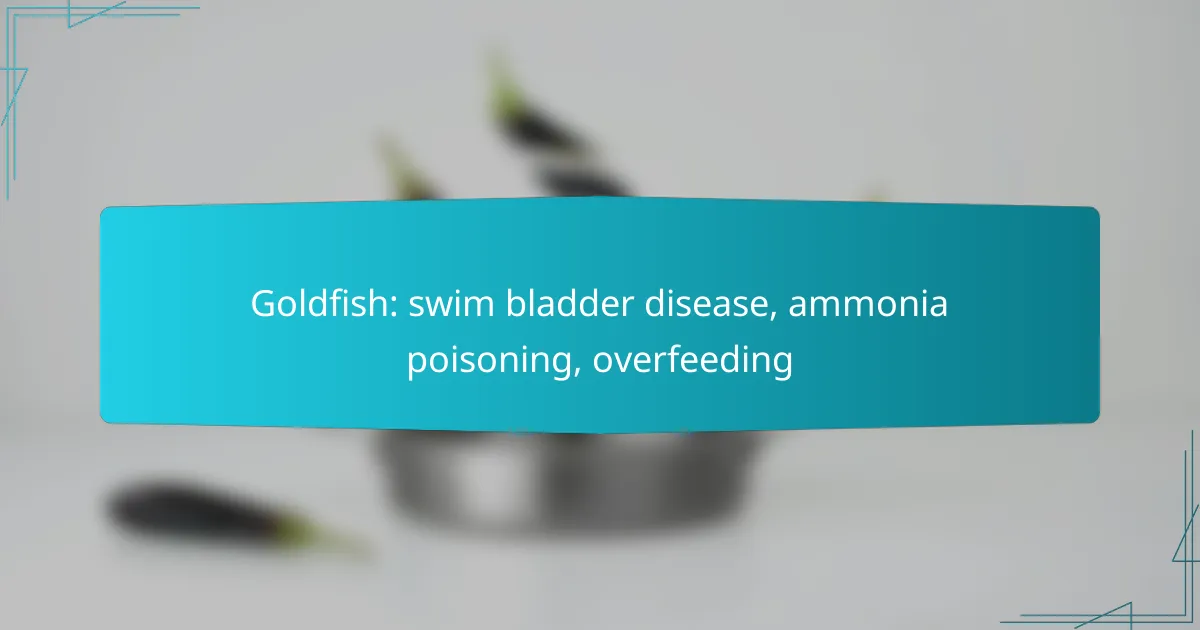Angelfish are beautiful and popular aquarium fish, but they can exhibit aggression if not properly managed. To promote harmony, it’s crucial to create a balanced environment with adequate space and hiding spots, as well as to choose compatible tank mates. Additionally, maintaining optimal water quality and implementing disease prevention strategies are vital for keeping angelfish healthy and thriving.

How to manage angelfish aggression?
Managing angelfish aggression involves creating a balanced environment that minimizes territorial disputes. Key strategies include providing hiding spots, ensuring an adequate tank size, and carefully selecting tank mates.
Provide ample hiding spots
Hiding spots are essential for angelfish as they offer refuge from aggression. Use decorations like caves, plants, and driftwood to create these spaces, allowing fish to retreat when feeling threatened.
Aim for at least one hiding spot per angelfish in the tank. This can help reduce stress and territorial behavior, promoting a more harmonious environment.
Maintain a suitable tank size
A suitable tank size is crucial for reducing aggression among angelfish. A minimum of 50 gallons is recommended for a small group, as this provides enough space for each fish to establish its territory.
Overcrowding can lead to increased stress and aggression, so ensure you follow the one-inch-per-gallon rule for smaller fish and adjust accordingly for larger species like angelfish.
Introduce tank mates carefully
Introducing tank mates should be done with caution to prevent aggression. Choose peaceful species that can coexist with angelfish, such as tetras or rasboras, and avoid overly aggressive or fin-nipping fish.
When adding new fish, consider using a separate quarantine tank first. This allows you to monitor their health and behavior before introducing them to the main tank, helping to minimize stress and aggression during the transition.

What are the best practices for disease prevention in angelfish?
To effectively prevent disease in angelfish, it’s essential to implement a combination of quarantine procedures, optimal water quality maintenance, and preventive medications. These practices help ensure a healthy environment and reduce the risk of infections.
Quarantine new fish
Quarantining new fish is crucial to prevent the introduction of diseases into your established aquarium. Ideally, new angelfish should be kept in a separate tank for at least two to four weeks, allowing you to monitor their health and behavior without risking your main tank.
During the quarantine period, observe for any signs of illness, such as unusual swimming patterns or visible lesions. If any issues arise, treat them in the quarantine tank before introducing the fish to your main aquarium.
Maintain optimal water conditions
Maintaining optimal water conditions is vital for the health of angelfish. Regularly test the water parameters, including pH, ammonia, nitrite, and nitrate levels, to ensure they remain within safe ranges. For angelfish, a pH of 6.5 to 7.5 and low ammonia and nitrite levels are ideal.
Perform regular water changes, typically 10-20% weekly, to keep the water clean and free from harmful toxins. Additionally, ensure proper filtration and aeration to support a stable and healthy environment.
Use preventive medications
Using preventive medications can help protect angelfish from common diseases. Consider adding medications that target parasites and bacterial infections during stressful periods, such as after transport or during tank maintenance.
Always follow the manufacturer’s instructions regarding dosage and duration of treatment. Regularly consulting with a veterinarian or an aquarium specialist can also provide tailored advice on preventive measures suitable for your specific setup.

How to ensure optimal water quality for angelfish?
To ensure optimal water quality for angelfish, maintain clean water through regular changes, monitor pH and temperature, and utilize quality filtration systems. These practices help create a stable environment that supports the health and well-being of your fish.
Regular water changes
Performing regular water changes is crucial for maintaining water quality in an angelfish tank. Aim to change about 10-20% of the water weekly to remove toxins and replenish essential minerals. This practice helps prevent the buildup of harmful substances that can stress or harm your fish.
Be cautious not to change too much water at once, as this can disrupt the tank’s ecosystem. Gradual changes are more effective in maintaining stability. Always use a water conditioner to remove chlorine and chloramine from tap water before adding it to the tank.
Monitor pH and temperature
Monitoring pH and temperature is essential for the health of angelfish. Ideally, the pH should be maintained between 6.5 and 7.5, while the temperature should range from 24°C to 28°C (75°F to 82°F). Sudden fluctuations can lead to stress and disease.
Use a reliable aquarium thermometer and pH test kit to regularly check these parameters. If adjustments are needed, do so gradually to avoid shocking the fish. Consider using a heater with a thermostat for consistent temperature control.
Use quality filtration systems
Investing in a quality filtration system is vital for keeping angelfish healthy. A good filter not only removes debris but also helps maintain water clarity and quality by promoting beneficial bacteria growth. Look for filters rated for at least double the tank’s volume to ensure adequate filtration.
Regularly clean and maintain your filter according to the manufacturer’s instructions. Replace filter media as needed, but avoid changing all media at once to preserve beneficial bacteria. This balance helps keep the water clean and safe for your angelfish.

What are the signs of stress in angelfish?
Signs of stress in angelfish can manifest through changes in behavior, physical symptoms, and increased hiding. Recognizing these indicators early can help prevent serious health issues and improve the overall well-being of your fish.
Change in behavior
A change in behavior is often one of the first signs of stress in angelfish. You may notice increased aggression, such as chasing or nipping at tank mates, or lethargy, where the fish becomes less active and spends more time at the bottom of the tank.
Additionally, angelfish may exhibit erratic swimming patterns or frequent darting around the tank. These behavioral changes can indicate that the fish is feeling threatened or uncomfortable in its environment.
Physical signs of illness
Physical signs of illness in angelfish can include faded colors, frayed fins, or unusual growths on their bodies. A healthy angelfish typically has vibrant colors, so any dulling can be a clear indicator of stress or illness.
Look for signs of parasites or infections, such as white spots or lesions. Regularly inspecting your fish can help catch these issues early, allowing for prompt treatment.
Increased hiding
Increased hiding is a common response to stress in angelfish. If your fish frequently seeks refuge behind decorations or plants, it may be trying to escape perceived threats or discomfort in the tank.
While some hiding is normal, excessive hiding can indicate that the fish is not feeling secure in its environment. Ensure that the tank is adequately decorated to provide hiding spots while also allowing open swimming space to reduce stress levels.

What are the ideal tank conditions for angelfish?
The ideal tank conditions for angelfish include maintaining a stable temperature and pH level that closely mimic their natural habitat. Proper water quality is crucial for their health and well-being, reducing stress and preventing disease.
Temperature range of 76-82°F
Angelfish thrive in a temperature range of 76-82°F (24-28°C). Keeping the water within this range promotes optimal metabolic function and overall health. Sudden temperature fluctuations can stress angelfish, making them more susceptible to illness.
To maintain the desired temperature, use a reliable aquarium heater and monitor the water with a thermometer. Regularly check the heater’s functionality to prevent overheating or cooling.
pH level between 6.5 and 7.5
The pH level for angelfish should be maintained between 6.5 and 7.5 for optimal health. This slightly acidic to neutral range mimics their natural environment, promoting comfort and reducing stress. Deviations from this range can lead to health issues and behavioral problems.
Test the water regularly using a reliable pH test kit, and adjust as necessary with pH buffers. Avoid rapid changes to pH, as this can shock the fish and lead to complications.










